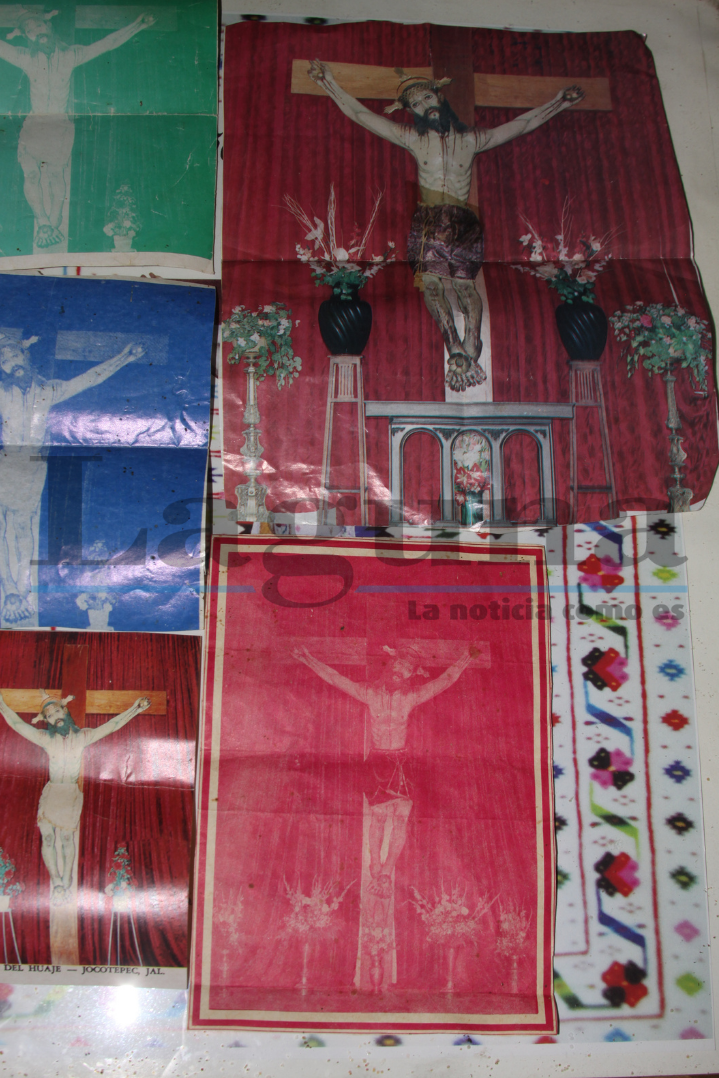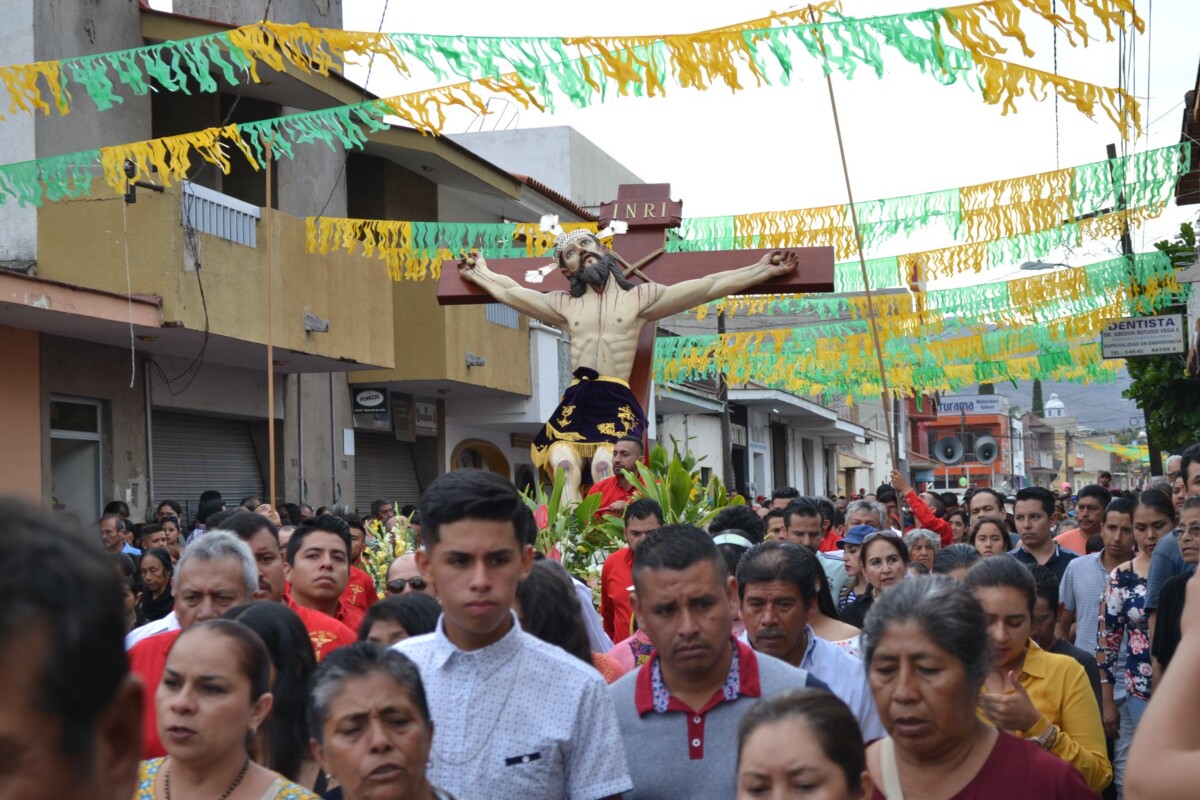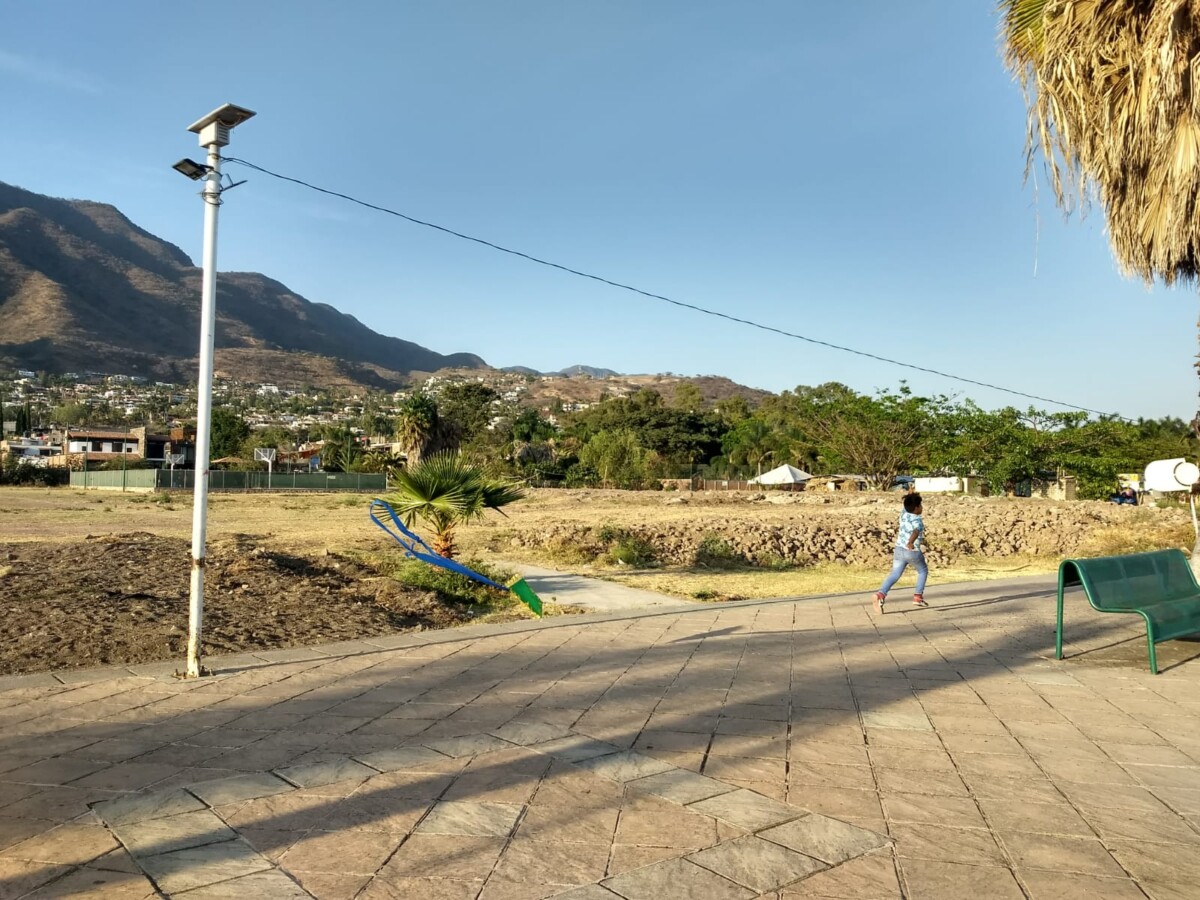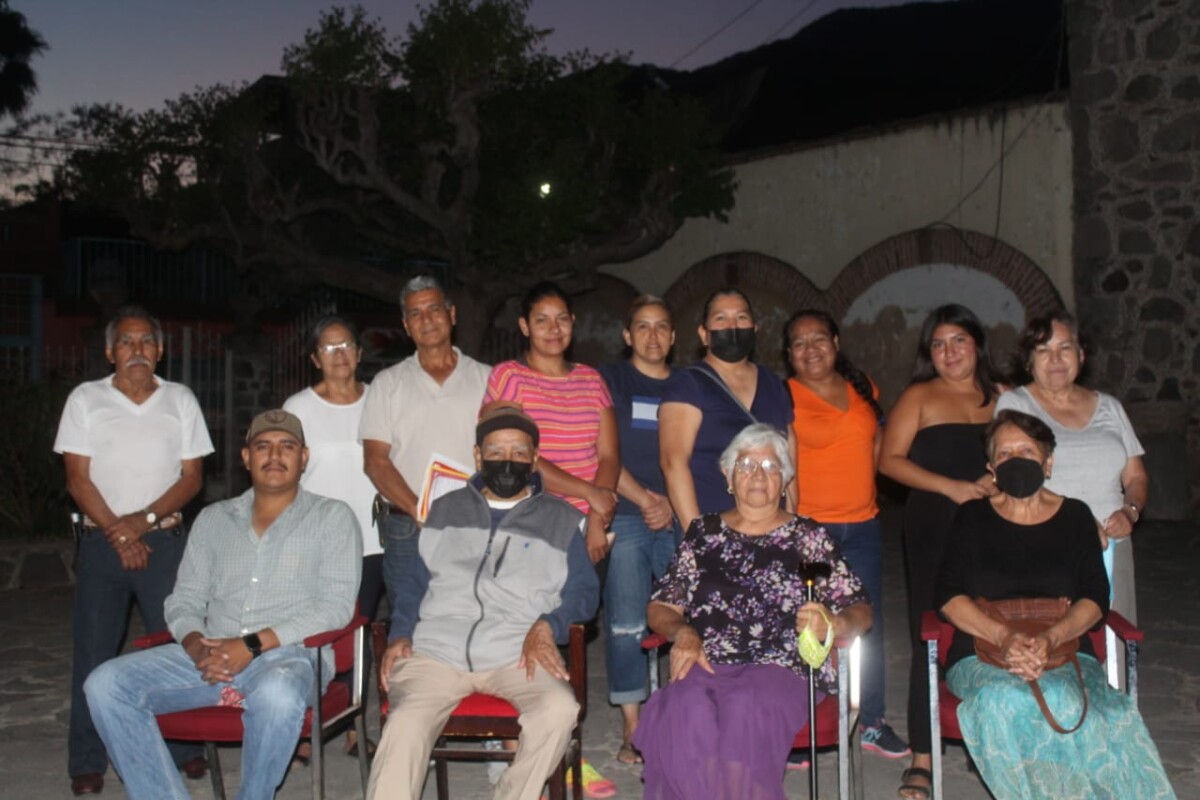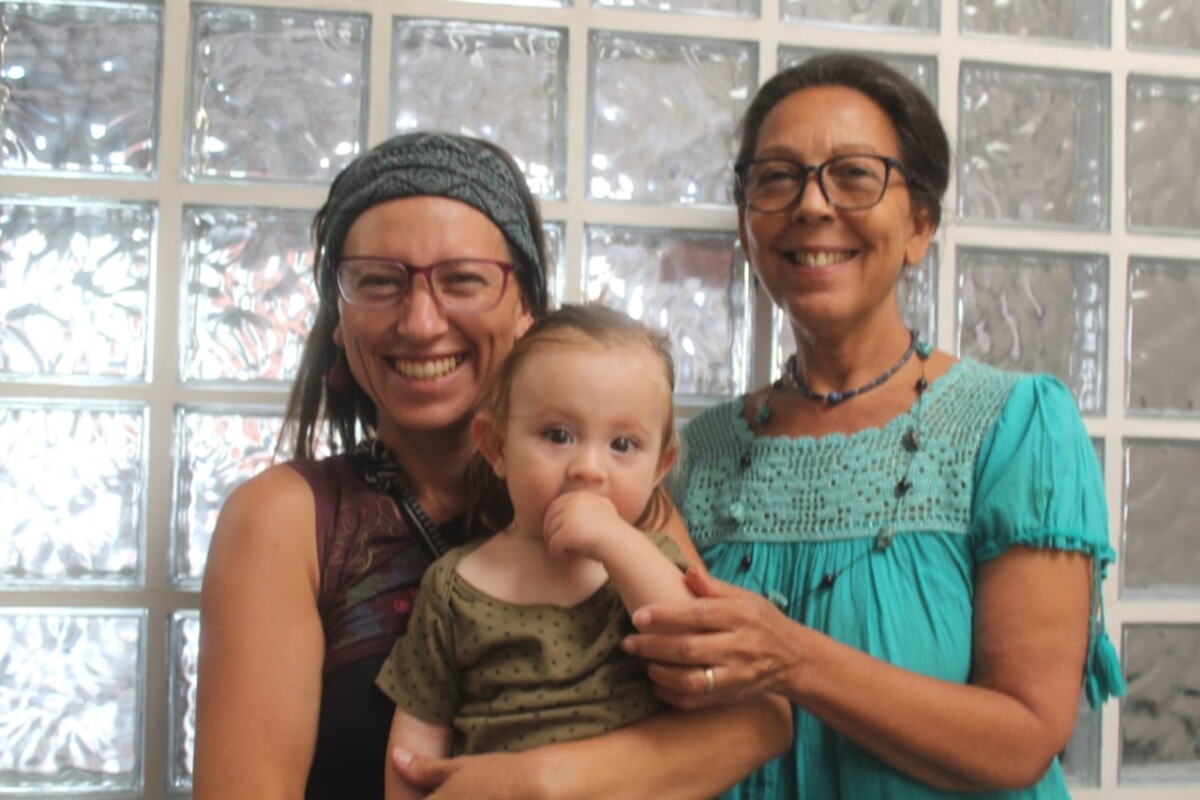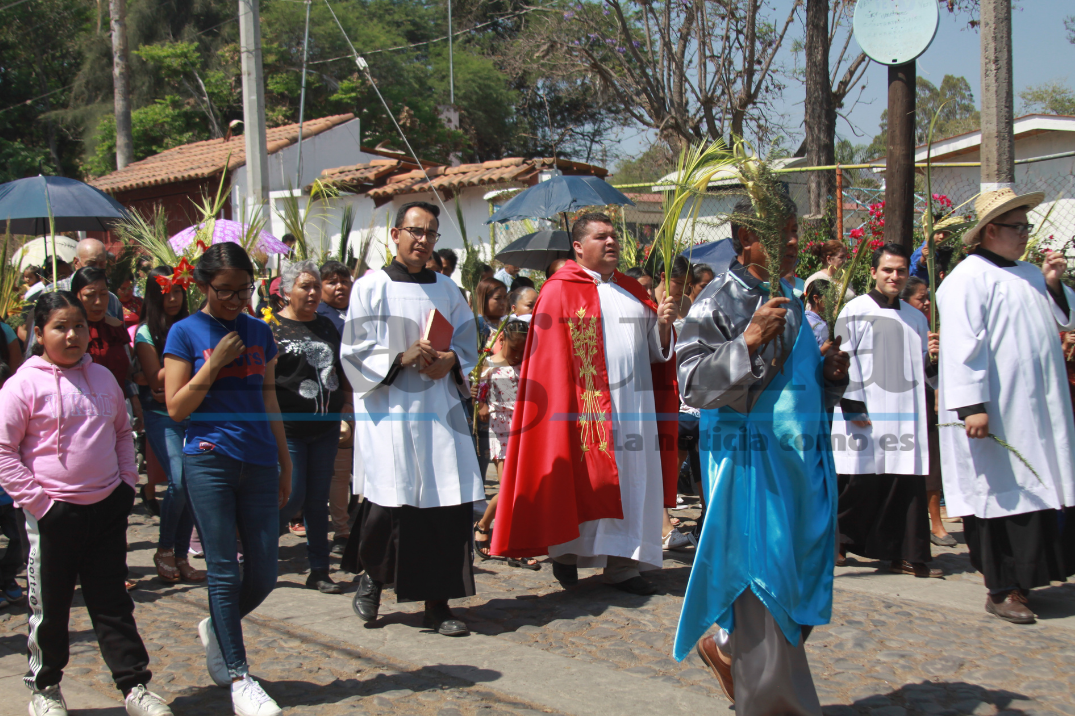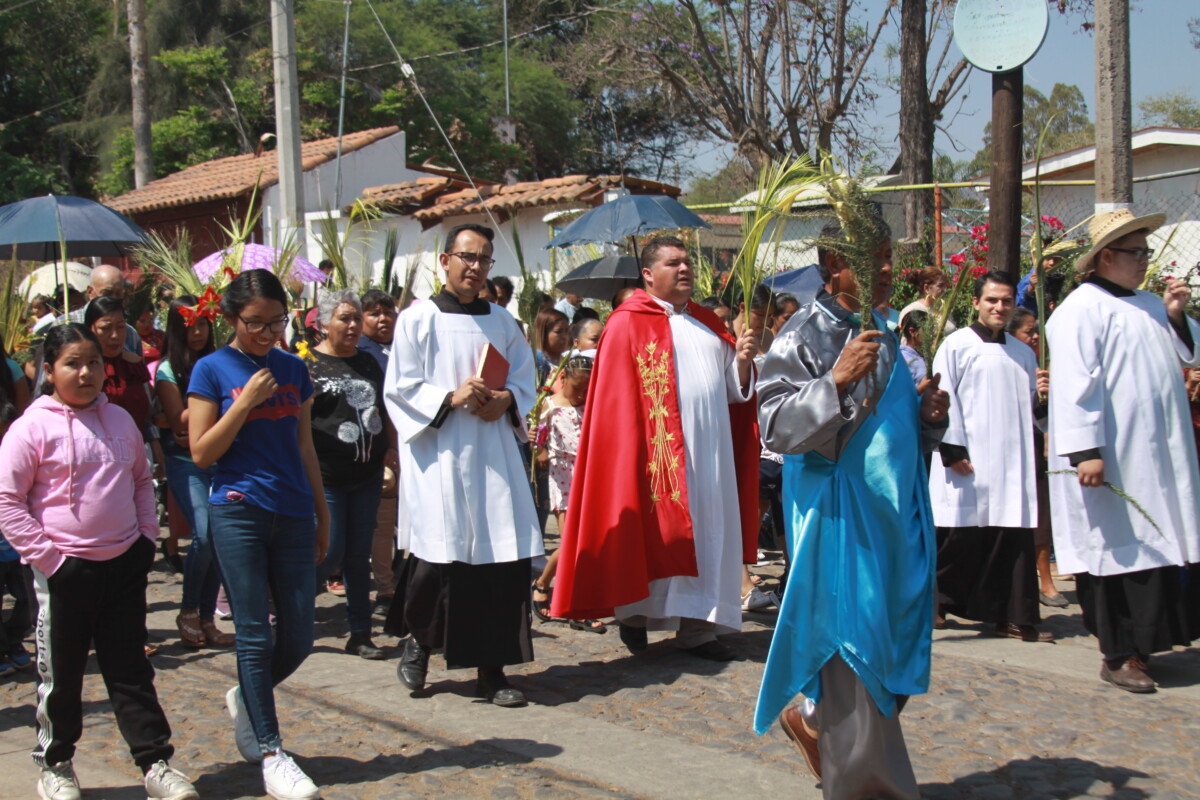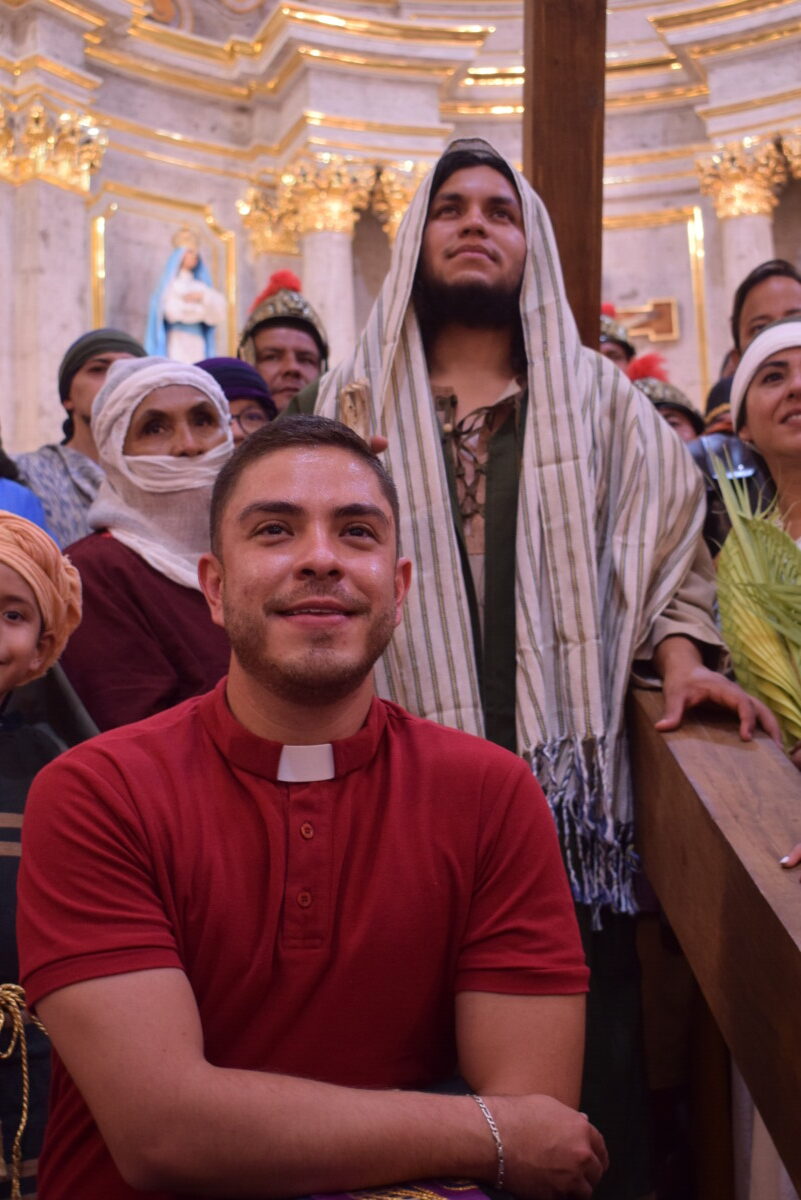tradiciones
Los milagros del Señor del Huaje
Bertha Mendoza Díaz profesa un gran fervor a la imagen del Señor del Huaje.
Fotos y texto por: María del Refugio Reynozo Medina:
Sus padres les enseñaron que Dios existe; no con palabras, sino con amor. Bertha Mendoza Díaz tiene 73 años y es originaria de Jocotepec; ella y su hermano Cándido Mendoza Díaz crecieron viendo la amorosa devoción al Señor de Huaje por parte de sus padres.
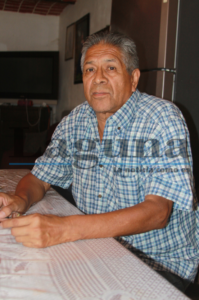
Cándido Mendoza Díaz es obrajero, músico, maestro de arte de preparatoria y profesa un amor por el Señor del Huaje inculcado por sus padres.
Su padre, Cirilo Mendoza Valencia, uno de los obrajeros de Jocotepec, enseñó el oficio a Cándido quien además de obrajero es músico y ha sido maestro de artes de Preparatoria por 24 años.
Cirilo Mendoza siempre quiso ser parte de los organizadores de la fiesta del Señor del Huaje. Le profesaba una gran devoción, pero no era integrante de ningún grupo.
Hasta sus oídos llegó la noticia de que era el último año que se celebraba al Cristo por falta de recursos económicos. Era por el año de 1970. Don Cirilo pidió participar, y para ello sólo tuvo que acudir a la parroquia del Señor del Monte para pedir unas cortinas y candelabros prestados pues el recinto del Señor del Huaje no tenía.
Don Cirilo acudió con el señor cura para pedirle en préstamo lo necesario.
El señor cura le dijo:
-Si alguna de las cosas se pierden, las pagarás.
-Si es necesario quedarme con él a dormir me quedo, le contestó.
La noche de la víspera de la fiesta, el grupo de ayudantes se dispuso a cerrar la puerta una vez terminado el adorno; la puerta permaneció inmóvil no podía cerrarse ni siquiera con la ayuda de los demás.
Entonces recordó que había prometido quedarse a dormir con él.
Los organizadores solidarios se unieron a don Cirilo y fueron por sus artículos personales para pasar la noche en vela. Algunos de ellos eran Ángel Paz, Benito Inés y Catarino Olmedo.
Cuando estuvieron de regreso y ya se disponían a acomodarse, intentaron cerrar el pesado portón de madera. Ante la mirada de todos, el portón cerró. Entonces volvieron a sus casas.
-Nos estaba tanteando- dijo uno.
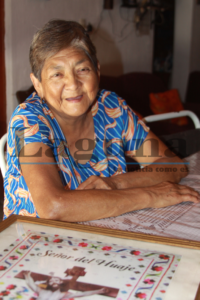
Bertha Mendoza Díaz conversa sobre los testimonios de fe.
Las primeras celebraciones en honor a este Cristo eran sólo de dos días: sábado y domingo; en los días posteriores a la fiesta de enero. Luego se concretó la celebración de un novenario.
La señora Bertha continuó con el amor hacia la imagen y estuvo muy cercana a las actividades del templo.
Aunque en el templo no siempre se vivió la contemplación amorosa; recuerda a un señor cura Emeterio Romo se llamaba, para la señora Bertha y otros vecinos, siempre fue muy extraño su actuar.
Decía que por qué hacían tanta fiesta, le daban alergia las flores.
Cuando le solicitaban autorización para la fiesta, se portaba renuente.
-Son nuestros cristos aparecidos- le decían las mujeres.
-Cristos aparecidos, monos de palo- arremetía el cura.
En una ocasión por el año del 75 Bertha se enteró que se llevaba a cabo una junta para cambiar la fecha de la fiesta, ella junto con más personas no estaba de acuerdo y trataron de impedirlo. Al final cambiaron a la actual fecha de mayo, pero en enero de ese año también lo celebraron.
La última, fue la fiesta de los excomulgados les decían a quienes participaron en ella. La primera vez que celebraron la fiesta en mayo, los organizadores mandaron citar a los organizadores de la de enero, a través de la presidencia para que les prestaran la plataforma. Los ánimos se crisparon y unos y otros estaban en pugna por la mentada plataforma.
Al final se las prestaron y ese año el Señor del Huaje tuvo dos fiestas y muchos fieles que se congregaron en torno a la imagen.
Se dicen muchas cosas de ese Cristo, alguien dijo una vez que entreabrió los labios. Algunos dicen que a veces se hace muy pesado. O que no siempre, las fotos que les son tomadas salen.
Contaban también que un hombre le prometió unas cortinas, y como no las compraba, una tarde llegó un señor a su casa llevando unas cortinas.
-Aquí encargaron unas cortinas- dijo.
Y solicitó el pago.
-No te hagas el chocante – alguna vez le dijo una mujer con cariño.
La señora Bertha profesa un gran amor por este crucificado y conversa de cerca con él. En una ocasión, a su nieta le robaron una camioneta. “¿Por qué?”, pensó y cuestionó para sus adentros; “era la camioneta o ustedes”, escuchó en el fondo de su corazón.
En una ocasión, pensó que todo había terminado, le diagnosticaron un tumor, la intervención era urgente, y antes de partir para el hospital, Bertha se arrojó a los pies del crucificado suplicando por su salud, cuando estaba en el hospital sometida a los exámenes clínicos, los médicos no encontraron nada maligno. En su corazón comprendió que fue él.
¿Qué si lo quiero?
Me dice con una mirada lejana.
¡Ay que si no lo quiero! dice con una franca sonrisa, muy cerca del llanto.
-Yo no sólo he escuchado de él, desde el vientre de mi madre lo he vivido y amado.
The celebration of the Señor del Huaje returned to Jocotepec
Processions of the Señor del Huaje in previous years.
Héctor Ruiz Mejía (Jocotepec).- After two years of suspension due to the pandemic, the festivities in honor of the Lord of Huaje, in the municipality of Jocotepec, returned.
The activities began April 23, with fireworks shows, regional music in the main square, and daily processions that have traveled to different localities and neighborhoods of the municipality, with participation by all parts of society. During the celebration, a carved wooden Christ, three meters high and weighing approximately half a ton, also known as the Santo Cristo de la Expiración, once again walked the streets of the town after two years of prohibitions and confinement due to the Covid-19 pandemic.
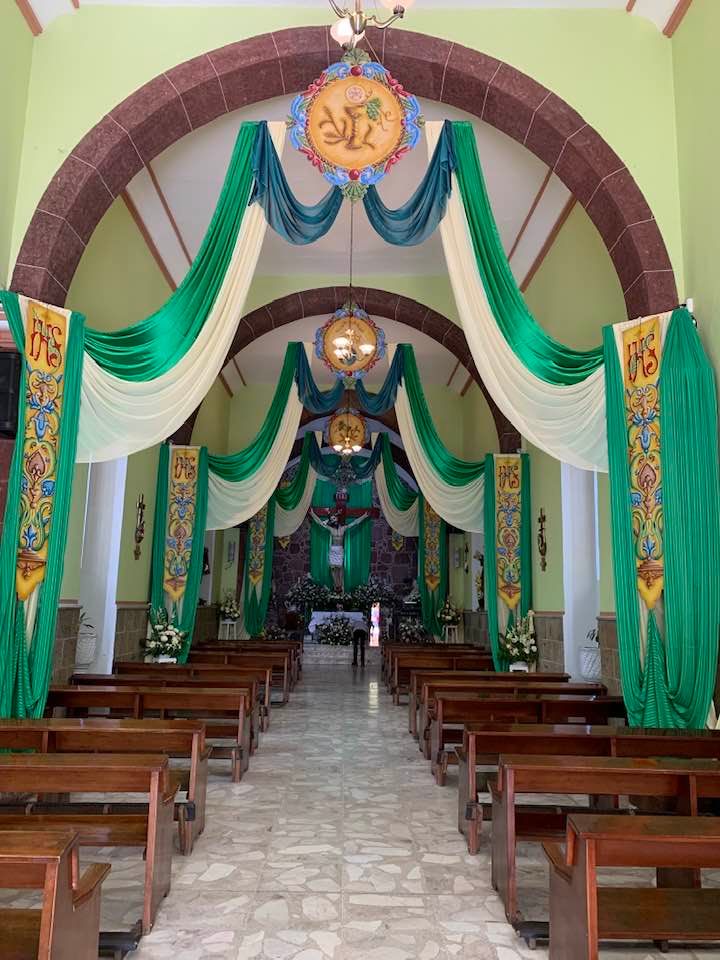
This is how the Señor del Huaje Church looks this year, ready for its festivities.
This year carnival games and rides occupied Miguel Arana Street up to its intersection with Guadalupe Victoria, so that all this week, traffic was affected and those attending had to find alternative places to park.
This Sunday, May 1st, the festivities culminated with the Solemn Procession with the blessed image of the Lord of Huaje, which began at 5 pm traveled through the main streets to return to the mass at 7 pm in the atrium of his chapel.
At the end of the Eucharist, residents enjoyed the music, dances and food stalls, as well as the carnival rides and games and the fireworks display, produced by the masons’ guild this year.
The cult of the Señor del Huaje is one of the oldest in the region, since its appearance dates back to 1715 in a guaje tree in what today comprises a property located in the town of San Pedro Tesistan.
Translated by Patrick O’Heffernan
FOTOGALERÍA:
El Señor del Huaje es el Cristo más importante para el municipio de Jocotepec, pues desde su aparición hace poco más de 306 años, propició el culto de los otros dos Cristos importantes para la comunidad ribereña. Foto: Héctor Ruiz.
Héctor Ruiz Mejía.- Con la participación de más de dos mil fieles, bajo el intenso calor, se reanudó la festividad del Señor del Huaje, luego de dos años de cancelación por la pandemia.
El Cristo, con más de 306 años de historia, dio su tradicional recorrido por las calles de la cabecera de Jocotepec, donde, escoltados por la Guardia de Honor, el Mariachi Nuevo San Juan y los fieles, inundaron las calles tras su salida de la Iglesia.

El Cristo de más de media tonelada de peso, es venerado antes de ser montado y bajado para su procesión. Foto: Héctor Ruiz.

Alrededor de las cinco y media, comenzaron las maniobras para desmontar al Señor del Huaje de su base en la Iglesia y dar la tradicional procesión. Foto: Héctor Ruiz.

La Iglesia del Señor del Huaje, hasta el tope de gente, esperando a que salga el Cristo por las calles del municipio. Foto: Héctor Ruiz.

Bajo el intenso calor y la resolana, comenzó la procesión por las calles. Foto: Héctor Ruiz.

El Señor del Huaje, siendo transportado desde la parroquia hasta el carro alegórico donde se instaló para ser transportado por las calles de Jocotepec. Foto: Héctor Ruiz.

Las calles del municipio, inundadas de fieles, que seguían al Cristo. Foto: Héctor Ruiz.
Chronicles of La Ribera
The character of Pontius Pilate, accompanied by his wife and the women of his palace.
There are a little over 50 actors on stage, including girls, boys and adult men and women. Since last February they began to prepare the representation of the Passion of Christ in the municipal capital of Jocotepec.
A few minutes before the beginning of the Stations of the Cross, the participants take care of the last details gathered in the pastoral house of the parish of Señor del Monte. They arrange their hairstyles and tunics and the leaders give instructions.

The actors leave the parsonage to begin the presentation.
Pedro Gómez Monreal is one of the organizers; also Benjamín Ramos Bautista. The last three weeks have been arduous rehearsals.
Lucia Mendoza is an elementary school teacher, she represents Pontius Pilate’s wife; she is dressed in a pearl-colored dress with satin sleeves and a golden diadem. For the teacher Luci it is extraordinary to be able to transmit a living God through the characters that she and her classmates represent.

The smallest of the actors is carried in his arms.
There is also her father, Don Pedro Mendoza, the wool serapes maker, who yesterday represented the apostle Peter. Today he appears along with men and women of the town.
-Yesterday I cried,» he says, saddened.
«It doesn’t feel good to deny my God, let alone three times».
Angel Gael Ramos also represents a boy from the agitated town that demands the Crucifixion of Jesus. From a very young age he has accompanied his parents and now he does so from the character assigned to him.
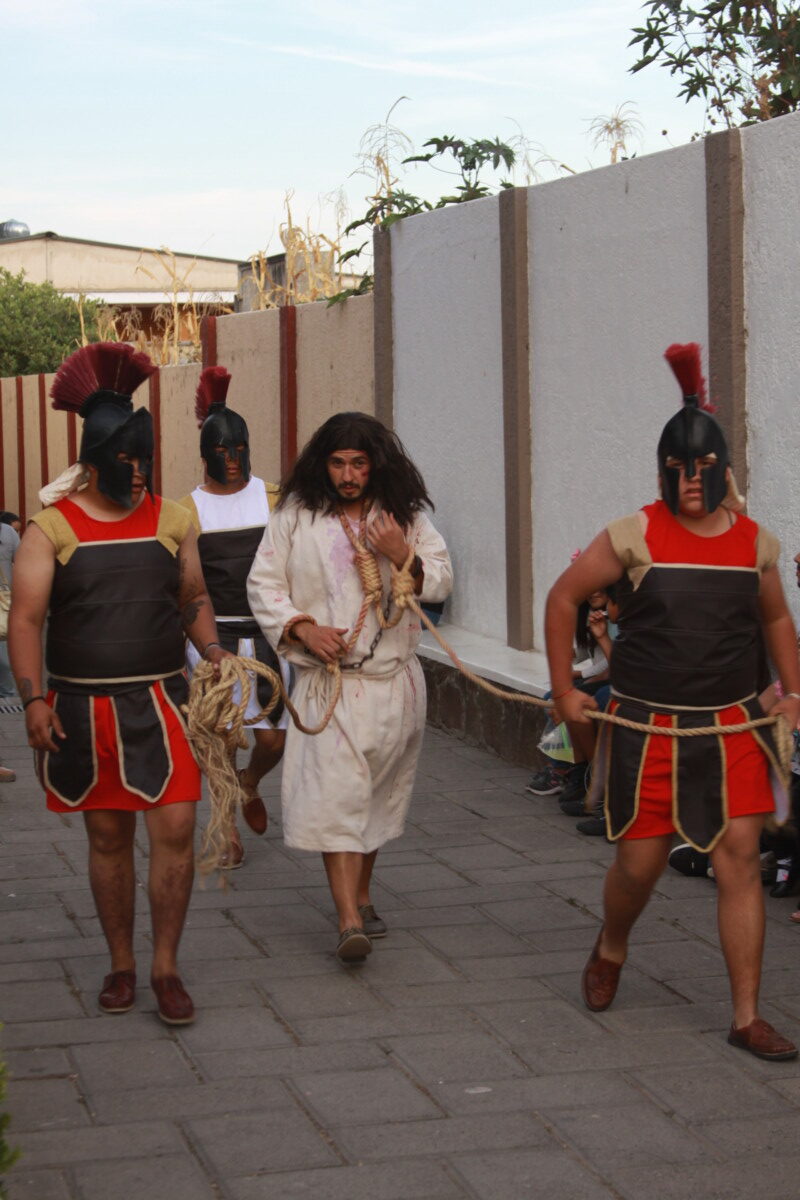
Jesus is escorted by the soldiers in his first appearance.
The Jesus Christ of this 2022 edition is represented by Cristian José López López.
The parishioners are already in the atrium waiting. The three stages of the first Stations of the Cross are ready. In the first one, Pontius Pilate appears, played by Pedro Gómez and his wife amidst purple curtains. On another stage is Herod surrounded by his servants. Jesus goes from one stage to another amidst pushing and whipping by the soldiers amidst the shouts of the people.

Herod from his court judges Jesus.
In another painting, there is a huge trunk to which the Nazarene is tied. There he is scourged before the eyes of the actors who represent the enraged mob and the parishioners who live the Stations of the Cross.
A girl of about ten years old, dressed in a brown tunic, watches with anguished eyes; she anxiously pinches a wooden cane that she carries in her hands.

Jesus about to be scourged.
Amidst mocking laughter and pushing and shoving, the enormous wooden cross is placed on the shoulders of the personage of Jesus Christ. The faithful continue to pray the Stations of the Cross through the main streets of Jocotepec.
The night has fallen, from the celestial vault a round and brilliant moon observes us. Next to the solemnity of the prayers, a woman appears with a tricycle selling corn, chickpeas, peanuts and snacks. Accompanied by a girl, she observes the passing of the Viacrucis and continues on her way. The diner is open, «Today tamales and atole », says a small sign. A woman who dines pauses as the procession passes by. The flower shop is also open and a few people watch the Stations of the Cross from inside.

The characters observe the scourging of Jesus.
On arrival at the church, the crosses of the thieves Dimas and Gestas are raised and the cross of Jesus Christ is being prepared. The people swirl around the final scene, the atrium remains in darkness; the disturbing faces of some of the assistants are illuminated by the lamps outside.
Soldiers place Jesus on the cross without his clothes, holding him by his hands and feet and then lifting him up, supported by thick ropes.
In the midst of the funeral atmosphere, the thunderous reggaeton coming from a Razer type vehicle that passes outside the temple interrupts the ceremony while the attendees ignore it.

A little girl, anguished, looks at the scourging and mockery directed to Jesus.
The scene is complete, the silhouettes of the three crosses can be seen amidst the foliage of the trees illuminated by a white light that focuses on the faces of the characters.
With a bloodied body, the crucified man pronounces his last words before the anguished gaze of the audience.
-Judas hanged himself,» shouts a male voice.
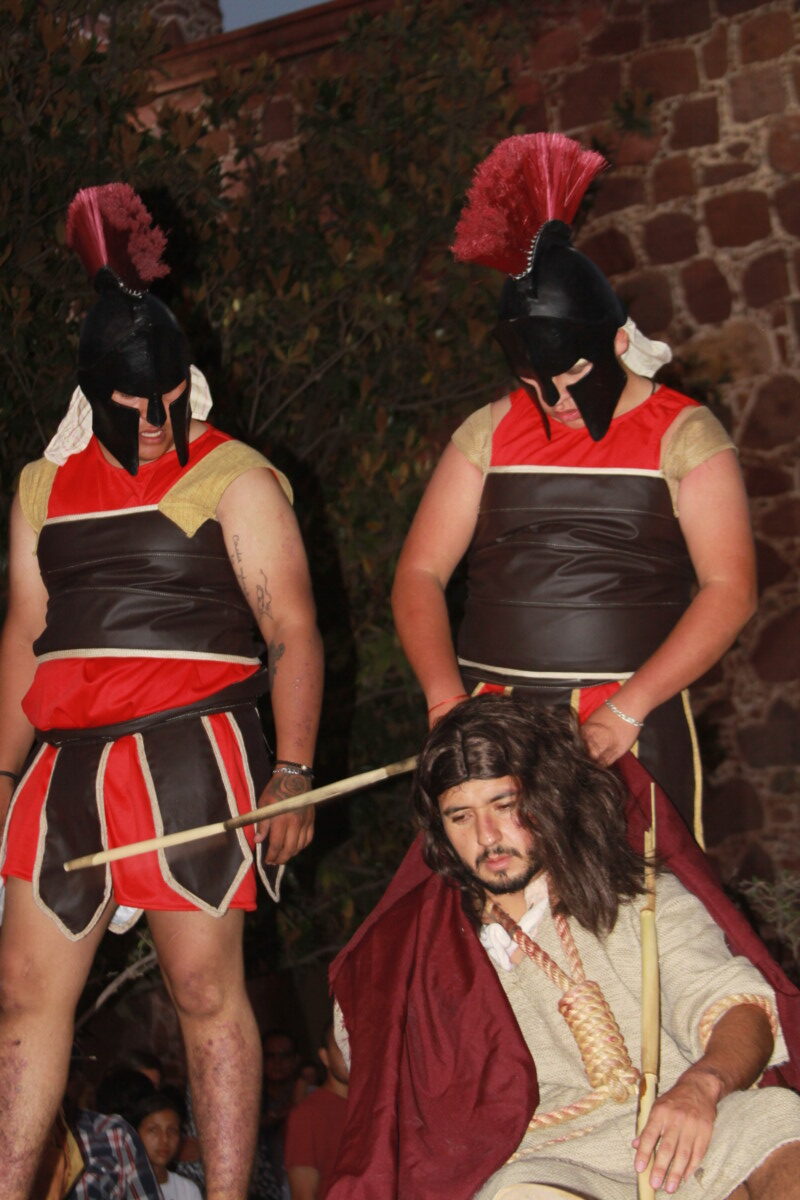
The soldiers are about to scourge the Nazarene.
And the people turn their gazes to the back stage where the silhouette of a man hangs from a rope.
The agony of Jesus is again interrupted by the Razer with the song that passes by for the second time sporting a bar of colorful light.
The faithful concentrate on the naked and battered figure of the crucified man who, on the verge of expiring, exclaims:
-In your hands I commend my spirit-.
-Into your hands I commend my spirit.
Immediately, a voice floods the scene.
-He is trembling!
And everyone kneels down.
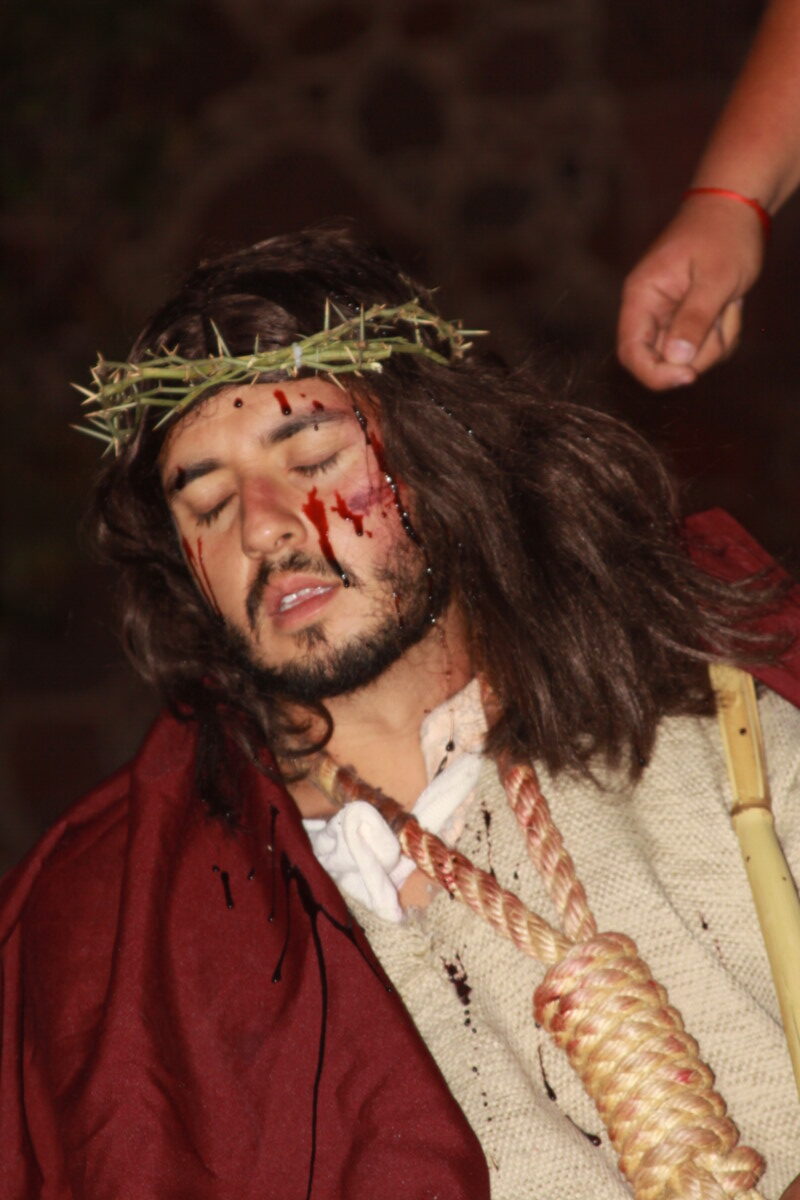
Jesus crowned with thorns.
At the foot of the cross is the character of Mary accompanied by John and another woman.
The young man playing John is indeed weeping bitterly. He takes Mary by the arm with a face bathed in tears, a face that is really living the Calvary and death of the true Son of God and wipes her tears again and again, because for him his companions are at that moment the characters of the sacred scriptures and the atrium of the parish, it is not the atrium, but Golgotha itself.
Translated by Patrick O’Heffernan
Kite Festival to celebrate Children’s Day
On April 30, Children’s Day, the first Kite (“Papalote”) Festival will be held in San Juan Cosalá, where between 100 and 150 children are expected to participate.
Héctor Ruiz Mejía.– On the occasion of Children’s Day, residents of the community of San Juan Cosalá are preparing to hold the first Kite Festival.
This event will take place next Saturday, April 30 at the San Juan Cosalá boardwalk, with the purpose of reviving the tradition of creating kites to fly them with the spring winds.
According to the organizers, although the original idea was to commemorate Children’s Day by painting and decorating the benches on the boardwalk, in the end it was decided to revive the tradition of the kites.
Organizers then set about the task of finding sponsors and people from the community to support the project, because although the materials are not expensive, «there is a cost, however minimal it may be».
The response has been good so far. The organizers say that the festival will take place on the boardwalk starting at 10:00 a.m. and is expected to have a total of between 100 and 150 children participating.
The requirement is that the children must be accompanied by at least one adult, since the goal is to provide an opportunity to bring families together, with the adults supporting the little ones in the construction of their own kite, and then learning to fly it together.
The event will be completely free, and children do not need to bring anything with them since all materials necessary to make the kites will be provided by the organizers.
«The only thing children need to come with is the desire to learn and have a good time, because once we finish making the kites, we will go to fly them in the field,» concluded the organizers.
Translated by Rebecca Zittle
Little Chapel of the Rosary needs more repair than estimated
Volunteers working on the repairs. Credit: Sofía Medeles.
Sofía Medeles.– Since the maintenance and repair work began on the Chapel of the Rosary, the group working on the project realized that the damage was greater than what was estimated before they began the restoration. Additional damage was found after work began; the workers found more cracks than they had initially noticed.
In an interview with Semanario Laguna, Josué Ramos, the current president of the volunteer group Sumando Voluntades, shared that the original project budget was $850,000 pesos (about US$42,000). After the National Institute of Anthropology and History (INAH) evaluated the building they said it could probably be repaired for less. Ramos asserted that a budget of $1,000,000 (US$50,000) is more feasible as they may uncover additional work that needs to be done. The group has only raised about $500,000 pesos (US$25,000).
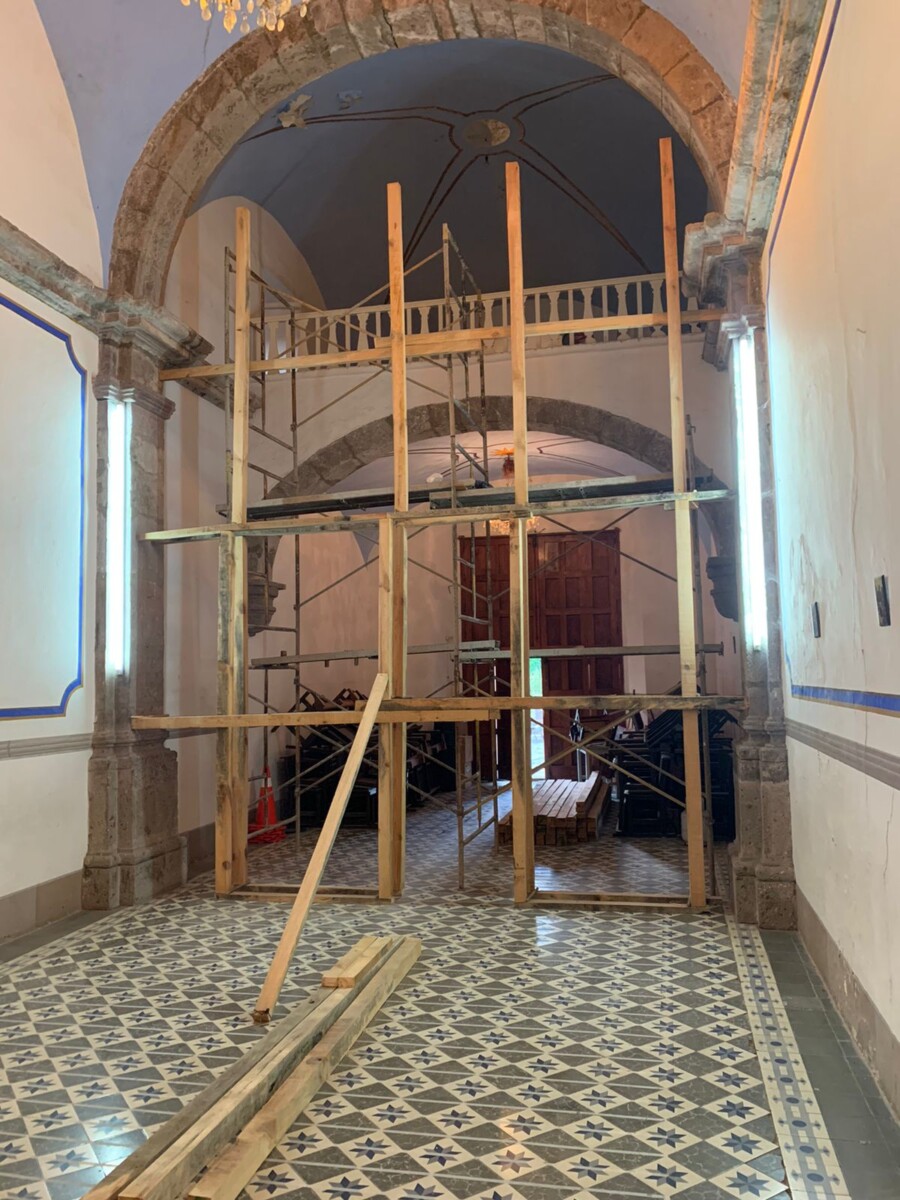
Work is in progress inside the chapel. Credit: Josué Ramos.
«INAH suggested only filling cracks and repairing the water damage in the roof, but we also want to fix the structural problems including reinforcing the structure, and the foundation. This will be evaluated after INAH’s visit, which will ensure that the structure remains as faithful as possible to its original design,» added Ramos. Another member of the group, treasurer Mónica Gutiérrez, assured that despite being more damage than they expected, they are already seeking bids to buy the necessary material to fill the cracks, and continue with the work on the roof.
The committee of Sumando Voluntades recently restructured after the death of their former president, Armando. The new officers are: president and architect Josué Ramos, secretary Juan Antonio Miramontes, and treasurers Monica Gutierrez and Honorata Gómez. To make donations, you can go to «Pollería Gutiérrez” in Ajijic, where one of the treasurers is located. You can also donate by going to any BBVA bank; use bank account number 4152 3137 0415 7622 in the name of Honorata Gómez to donate.
Translated by Amy Esperanto
Earth Day activities used awareness with spirituality
Event organizers and participants (from left to right): Nora Maldonado, Nora’s daughter Sol, and Noris Binet. Photo: Sofía Medeles
Sofia Medeles (Ajijic).- The activities of the Earth Day celebration on April 22, 23 and 24 were designed not only to raise awareness through the knowledge shared by the exhibitors and groups that attended, but also by means of the spiritual and educational aspects of the native history of the Chapala lakeside.
Two of the organizers, Noris Binet and Nora Maldonado, explained that spiritual elements and themes are included to promote an awareness that will be deeper and leave more of an impression on the attendees, without dismissing the work of the researchers and professionals who will be presenting.
Nora, who is part of the group «Guardians of the Lake,» said that spiritual events included an offering to the lake, in which flowers, fruits, seeds and other things that do not interfere with the flora and fauna of the ecosystem were left on the shore of the lake. This offering was on Sunday April 24 at 6:00 pm, as part of the closing of the festival.
They also said that their goal is to make this event an annual event and to involve more and more lakeside towns, as well as schools of all levels, and to involve students in the activities.
Some of the scheduled activities included conferences with activists such as Manuel Villagómez Rodríguez and Luis Valdivia, musical shows, eco-friendly technology exhibitions and children’s art contests.
Among the organizers are Douglas Reid, Sihara Casillas Gaeta and Noris Binet.
Translated by Rebecca Zittle
Crónicas de la Ribera
El señor Cura Carlos Enrique Medina Garibaldo preside la procesión del Domingo de Ramos en San Cristóbal Zapotitlán. Foto: María Reynozo.
Por: María del Refugio Reynozo Medina.
Las mujeres barriendo la plaza y el atrio del templo de San Cristóbal Zapotitlán anuncian la proximidad de una celebración: la misa solemne del Domingo de Ramos.
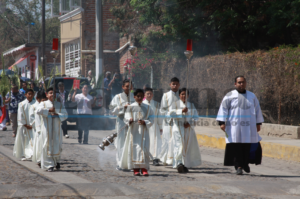
Cerca de un centenar de feligreses participan caminando encabezados por los niños acólitos. Foto: María Reynozo.
Están colocadas en la entrada del templo una fila de troncos de palma que forman un camino para llegar hasta el recinto. En el extremo, llevan una palma encajada en el centro que se levanta hacia el cielo.
Dos mujeres barren la escena, mientras en la plaza otras más recogen la basura con los primeros rayos del sol poco después de las ocho de la mañana.
Hoy, además de la celebración del Domingo de Ramos, se lleva a cabo la revocación de mandato 2022.
Alrededor de las 11:30 de la mañana, los feligreses se congregan en la calle Zaragoza de San Cristóbal, cerca del crucero. Llevan ramos de romero y manzanilla. Algunas mujeres cargan bebés en los brazos; otras en carriolas.
Un grupo de seis personas, cuatro mujeres y dos hombres, cargan palmas trenzadas de un verde claro, y dos de ellos sostienen una biblia en las manos mientras avanzan en la procesión.
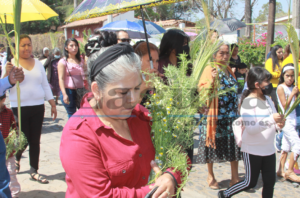
La manzanilla y el romero perfuman las calles al paso de la procesión. Foto: María Reynozo.
Un grupo de hombres enfundados en brillantes túnicas caracterizan a los apóstoles, mientras que un joven en el papel de Jesucristo camina vestido con una túnica blanca y un manto rojo. El señor Cura Carlos Enrique Medina Garibaldo encabeza la procesión que avanza entre cánticos y el aroma del copal.
El ambiente huele a romero, albahaca y manzanilla.
Al término de la celebración la gente se congrega en la plaza y muchos se recetan unos tacos de carnitas, tacos de bistec o una rebanada de flan.
Mientras tanto, en el local a unos metros de la escuela primaria están colocadas las urnas para llevar a cabo la consulta de revocación de mandato impulsada por el presidente de México, Andrés Manuel López Obrador.
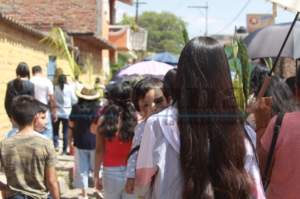
En la procesión participan niñas y niños que acompañan a sus padres. Foto: María Reynozo.
Las casillas abrieron desde las ocho y unos minutos; sin embargo, a las 8:30, aparecen solitarios una pareja de primeros votantes.
Están instaladas dos casillas; de la sección de 1668 y 1687. Cada casilla tiene un presidente, un secretario y un escrutador.
La afluencia de votantes es lenta; y de un padrón de unos tres mil votantes solo se registra la participación de 275 presentes cuya decisión mayoritaria es que el presidente en funciones permanezca.
Así transcurre el anunciado proceso de revocación; entre las campanas que llaman a misa y las urnas que llaman a votar en donde los fragantes ramos de romero superaron por decenas la participación de los ciudadanos.
Chronicles from La Ribera:
Curate Carlos Enrique Medina Garibaldo presides over the Palm Sunday procession in San Cristóbal Zapotitlán. Photo: María Reynozo.
By: María del Refugio Reynozo Medina
The women sweeping the square and the atrium of the temple of San Cristobal Zapotitlán announce the proximity of a celebration: the solemn mass of Palm Sunday.
A row of palm trunks are placed at the entrance of the temple, forming a path to reach the church. At the end, they carry a palm embedded in the center that rises towards the sky.
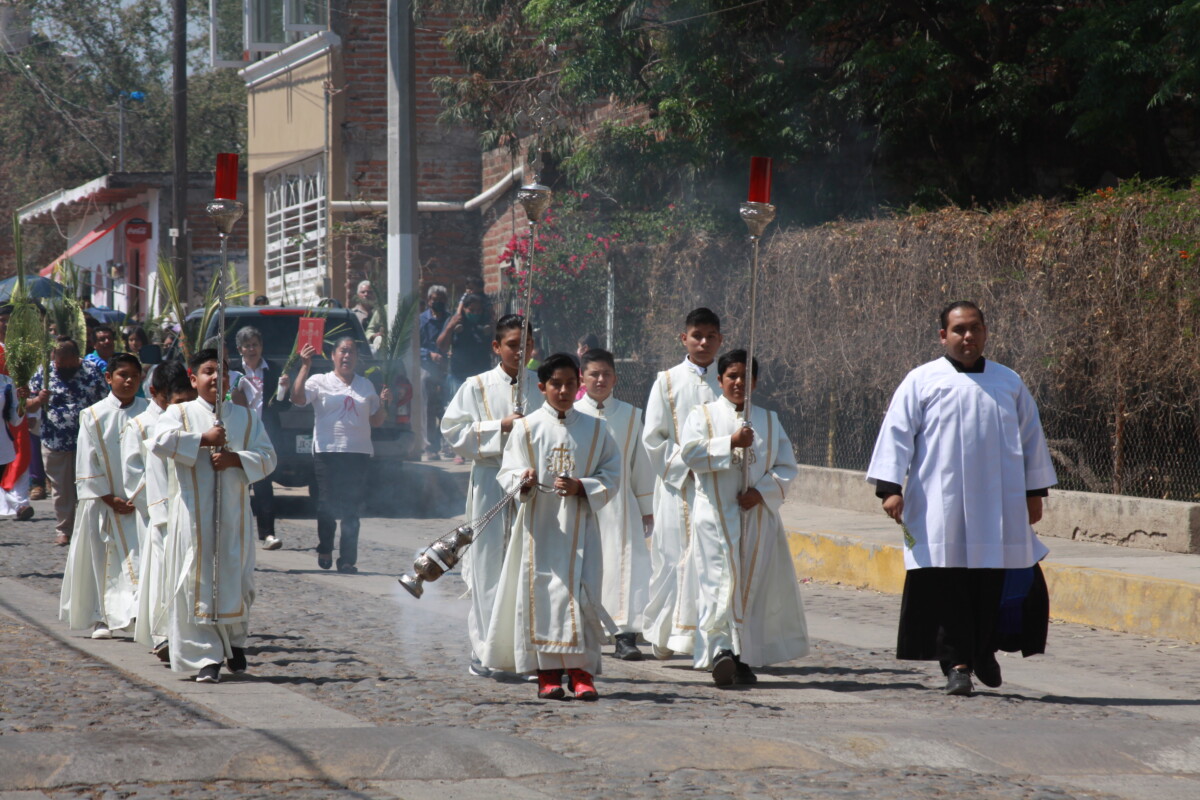
About a hundred parishioners participate walking led by the acolyte children. Photo: María Reynozo.
Two women sweep the scene, while in the square others pick up the garbage with the first rays of the sun shortly after eight in the morning.
Today, in addition to the Palm Sunday celebration, the 2022 recall election is taking place.
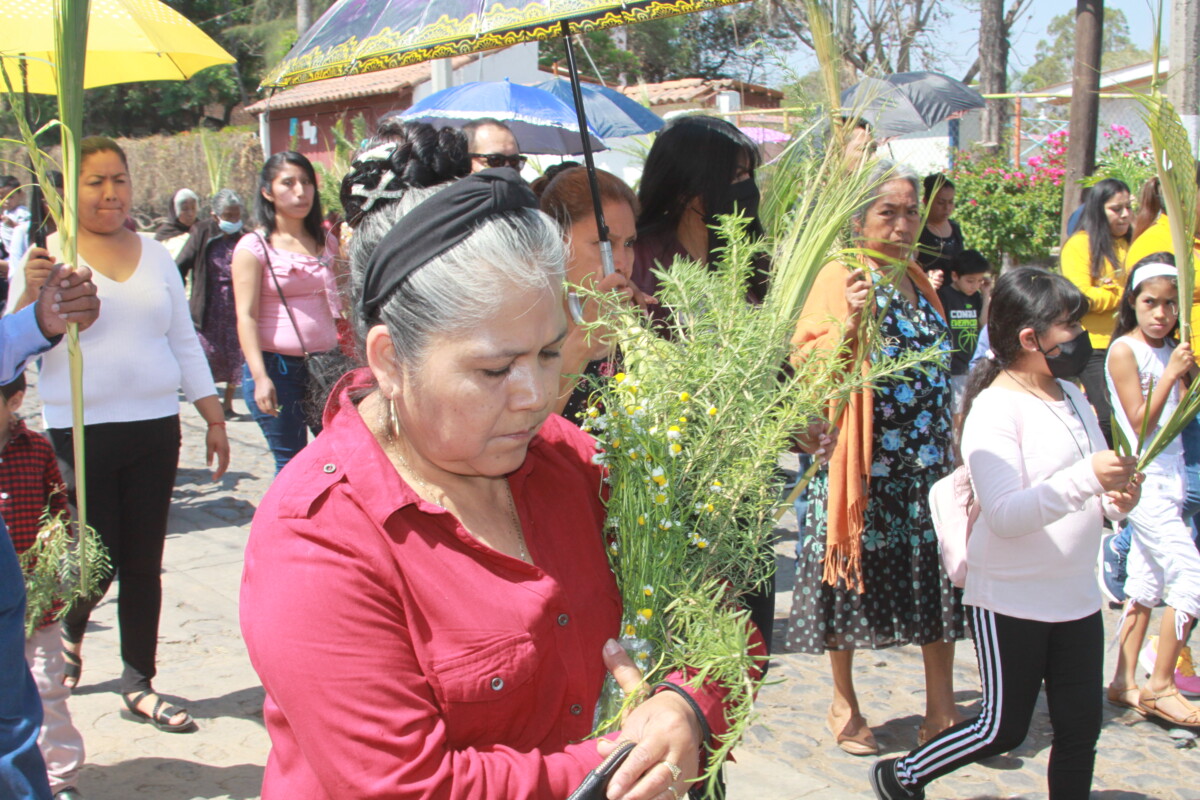
Chamomile and rosemary perfume the streets as the procession passes by. Photo: María Reynozo.
Around 11:30 a.m., parishioners congregate on Zaragoza Street in San Cristobal, near the crossroads. They carry bouquets of rosemary and chamomile. Some women carry babies in their arms; others in strollers.
A group of six people, four women and two men, carry light green braided palms, and two of them hold a bible in their hands as they advance in the procession.
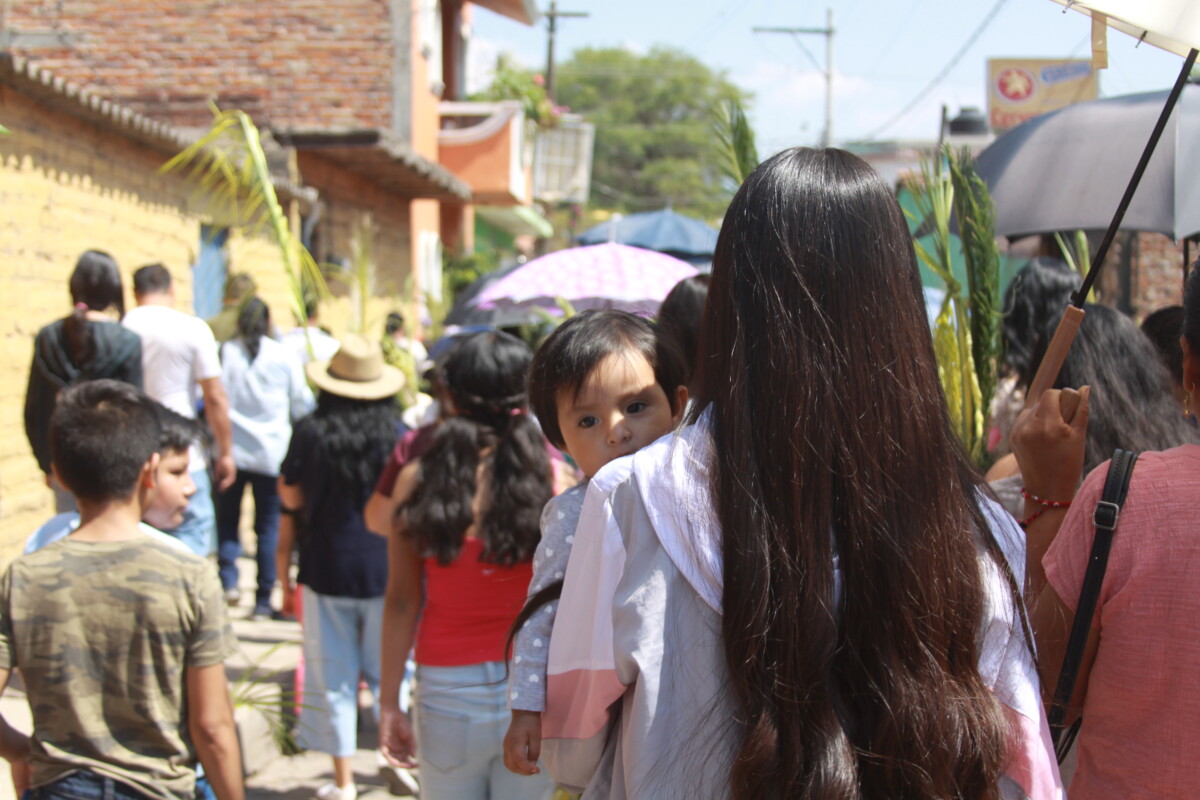
Children accompanying their parents participate in the procession. Photo: María Reynozo.
A group of men in bright robes characterize the apostles, while a young man in the role of Jesus Christ walks dressed in a white tunic and a red cloak. Cura Carlos Enrique Medina Garibaldo leads the procession that advances amidst chants and the aroma of copal.
The atmosphere smells of rosemary, basil and chamomile.
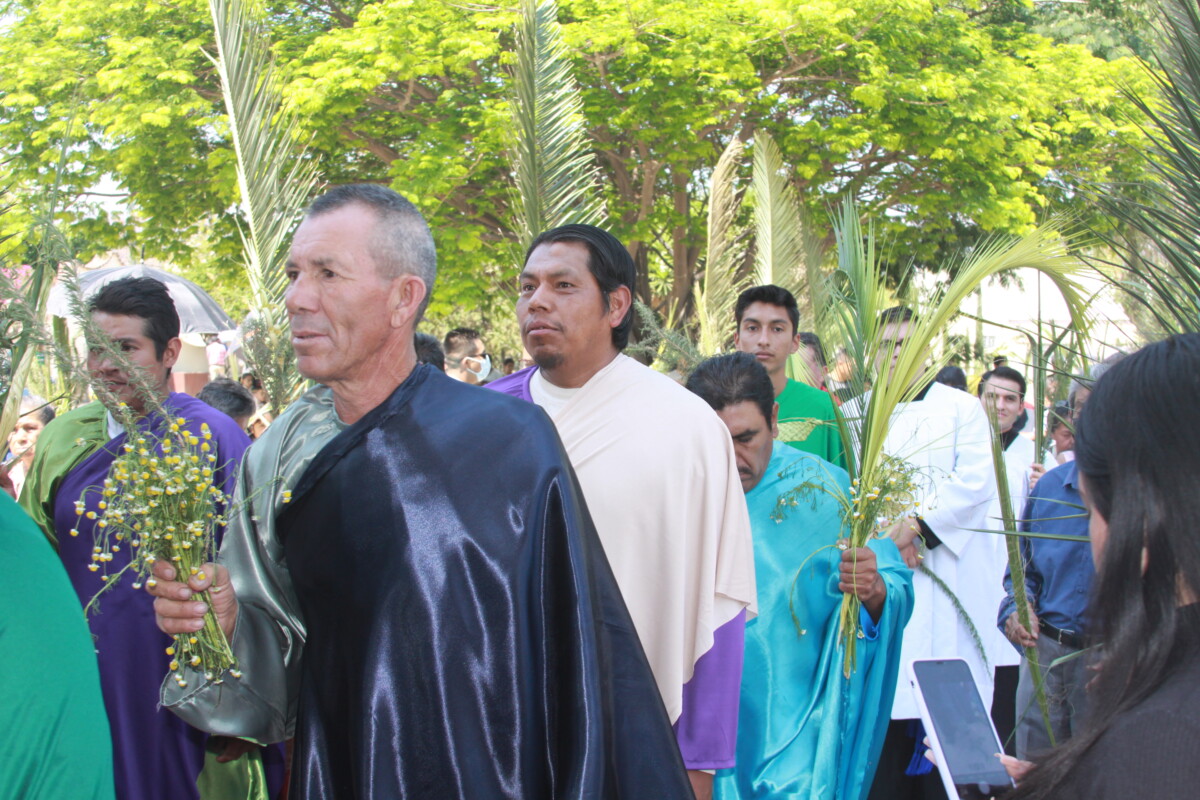
A group of men represent the apostles with their bright tunics. Photo: María Reynozo.
At the end of the celebration, people congregate in the plaza and many treat themselves to carnitas tacos, steak tacos or a slice of flan.
Meanwhile, in the premises a few meters from the elementary school, the ballot boxes are set up to carry out the recall referendum promoted by the President of Mexico, Andrés Manuel López Obrador (AMLO).
The polls opened at 8:00 a.m. and a few minutes later; however, at 8:30 a couple of the first voters appeared alone.
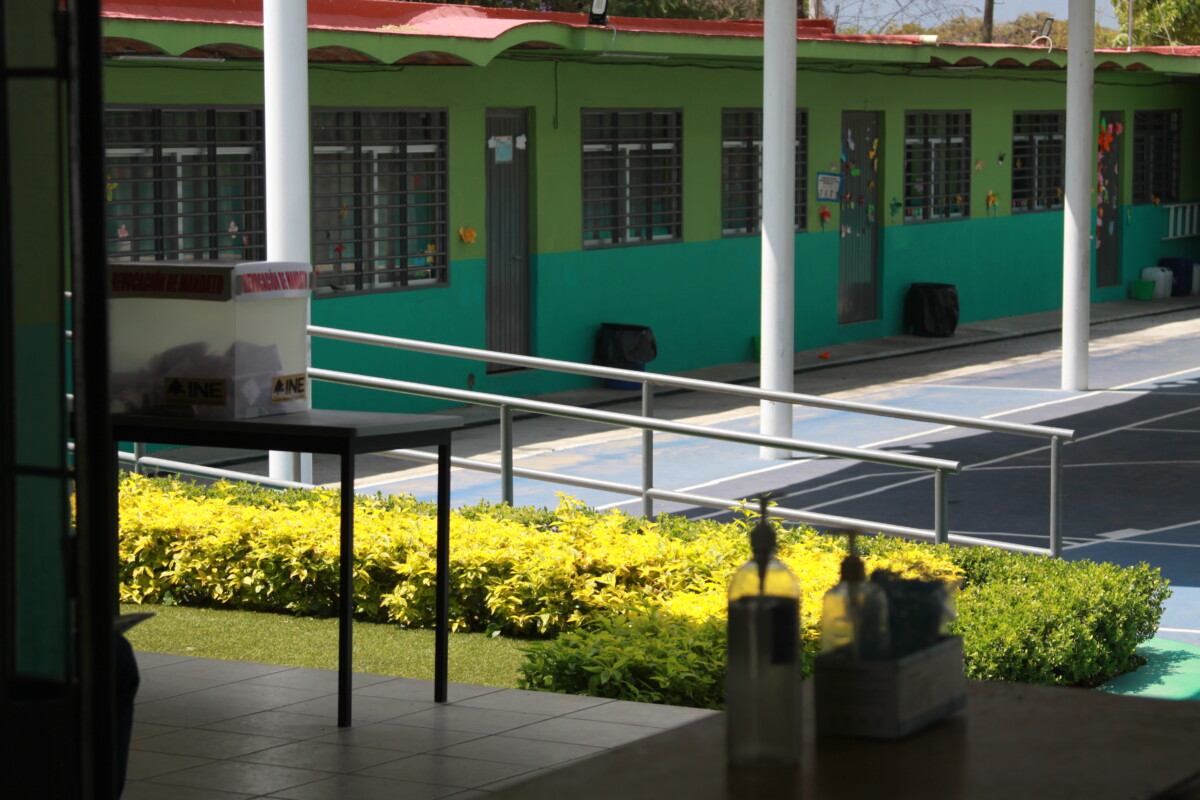
In the elementary school, the urns look lonely. Photo: María Reynozo.
Two polling places are installed; from section 1668 and 1687. Each polling place has a president, a secretary and a teller.
The arrival of voters is slow; and out of a voter roll of about three thousand, only 275 voters are present and the majority decision is for the incumbent president to remain.
This is how the announced recall process goes; between the bells that call to mass and the ballot boxes that call to vote where the fragrant rosemary bouquets exceeded by dozens the participation of the citizens.
Joel Salvador Torres Arrayga is the Jesus of the Passion of Christ Chapala 2022
Joel Salvador – Chapala. Torres Arrayga , who will portray Jesus in the Stations of the Cross and Passion of Christ Chapala 2022, next to Father Juan Manuel. Photo: Jazmín Stengel.
Jazmín Stengel.- Joel Salvador Torres Arrayga, originally from Chapala, was always devout and, although his work took him away from the ecclesiastical groups for a few years, he returned this year, to represent Christ during the Stations of the Cross and Passion of Christ Chapala 2022.
The 25-year-old was familiar with the Church throughout his life. Coming from a Catholic family, as a child he was an acolyte or altar boy in the parish of San Francisco de Asis. Years later, in his adolescence he was part of the Seminarians in Family (SemFam) group coordinated from the same parish, and during his high school years he was a member of the Salesian Missionary Group of Chapala.
This year, due to his long and curly hair, he was invited by the ‘Bola’ and Jesús Chávez to be part of the new group that re-enacts the Stations of the Cross and Passion of Christ in the municipal capital.
Translated by Patrick O’Heffernan
© 2016. Todos los derechos reservados. Semanario de la Ribera de Chapala
